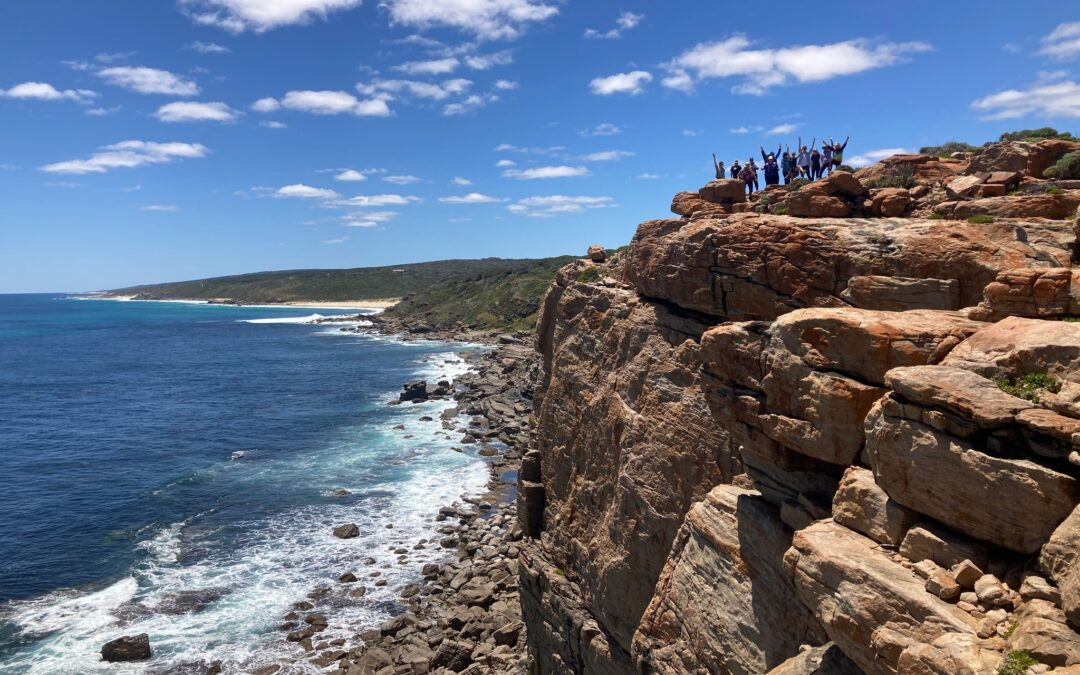Areas of coastal granite are like Noah’s Arks for rare and special plants, says Nature Conservation Margaret River Region – and you’re invited to help protect them at a series of upcoming volunteer days.
The community is urged to turn out to plant natives and protect them with brush at a volunteer busy bee at Cowaramup Bay on Sunday June 16 from 10am, as Nature Conservation teams up with the Shire of Augusta Margaret River, Friends of the Cape to Cape Track and the Gracetown-Cowaramup Bay community.
“Coastal granite outcrops are a recognisable feature of our beautiful coastal landscape. Our pristine sandy beaches, flanked by those russet rocks at places like North Point and Wyadup Rocks, are etched into our minds and souls,” says Nature Conservation’s Caring for Coast program officer Mandy Polley.
“These granite outcrops are also a unique ecosystem, offering a range of microhabitats. These are small, restricted areas that differ from the surrounding land. Part of the reason is because they often have wet areas on or between rocks, which support different kinds of plants that otherwise might exist in these exposed coastal conditions.”
Mandy says the areas of granite support many endemic species, “which means they exist here and nowhere else in the world”. Flora surveys show more than 550 native plant species are found on granite outcrops in our region. But these outcrops are under increasing pressure from people and development, with 25 per cent cleared since European settlement. Climate change, weeds, dieback, fire and visitors also pose a risk to these special areas.
“Our granite outcrops are so complex and beautiful. Plants are often hidden, compact and delicate, like little treasures,” says Mandy. “The easiest way to help protect these fragile environments is to stay on marked trails. Unfortunately, in granite areas these aren’t always obvious, so watch where you step and avoid trampling plants. Take care is the message.”
The uniqueness of the region’s granite communities was echoed by renowned botanist and conservation biologist Professor Stephen Hopper, who visited the region last year to share his observations of rare plants on the Leeuwin Naturaliste ridge at a special talk as part of Nature Conservation’s Environmental Sundowner Series.
The former Kings Park and Botanic Garden director – with 50 years’ experience observing the unique endemism of our region – said the rare flora in our coastal granite communities meant of Margaret River region was like “nowhere else on Earth”.
Professor Hopper said our shire is home to 50-plus species of caladenia or spider orchids alone, some which are only found in just one tiny pocket of granite country which is an example of “ultra-endemism”.
This Sunday’s community volunteer day will build on previous planting and brushing days at Cowaramup Bay. “This time we’ll be working to care for the area in front of the South Point carpark and Huzzas surf break, by planting natives and laying down brush to protect them,” says Mandy.
Nature Conservation Margaret River Region general manager Drew McKenzie said, with growing population and visitation to the region, it was more important than event that locals were ambassadors and stewards for our coast. He said keeping off dunes, sticking to formal pathways, removing dog poo and rubbish, volunteering at conservation events, and learning to identify weeds were all ways to care for our coast.
“The coast is a great source of fun and recreation for many of us, but our goal is to inspire locals to be custodians and stewards for the coast too,” he said. “Increasing use of the coast by the growing number of residents and tourists, together with other threats like climate change, are putting pressure on the fragile coastal region.”
Nature Conservation’s Caring for Coast program is funded through the Line in the Sand philanthropic group, while the Shire of Augusta Margaret River’s Environmental Management Fund is helping to put the spotlight on coastal education.

